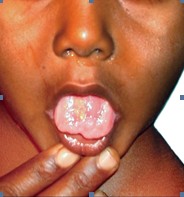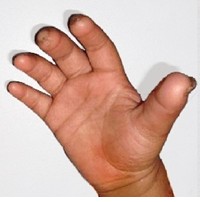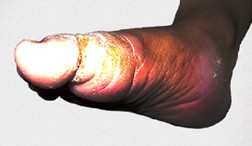Saeed Bin Ayaz, MBBS, FCPS*, Sumeera Matee, MBBS**, Muhammad Ikram, MBBS**, Zaheer Ahmed Gill, MBBS, FCPS*
*Consultant Physical Medicine & Rehabilitation, **Resident
Armed Forces Institute of Rehabilitation Medicine (AFIRM), Abid Majeed Road, Rawalpindi-46000 (Pakistan).
Correspondence: Dr Saeed Bin Ayaz, Consultant PM&R. Armed Forces Institute of Rehabilitation Medicine (AFIRM), Abid Majeed Road, Rawalpindi-46000 (Pakistan); E-mail: saeedbinayaz@gmail.com
ABSTRACT
Congenital insensitivity to pain with anhidrosis is a rare disease with an autosomal recessive inheritance. The patients present in early childhood with frequent episodes of fever and absence of sweating. Painless fractures, bruises and cuts are quite common. Defective lacrimation and mental retardation are strongly diagnostic. Repeated injuries often lead to a reduced life expectancy. The diagnosis depends on relevant clinical features, abnormal sensory response on nerve conduction studies and nerve biopsy showing loss of the unmyelinated and small myelinated fibers. We report here a 5 year old female child who presented for electrodiagnostic evaluation and was found to have this disease.
Key words: Congenital insensitivity to pain; Anhidrosis; Electrodiagnostic studies
Citation: Ayaz SB, Matee S, Ikram M, Gill ZA. Congenital insensitivity to pain with anhidrosis: a case report from Pakistan and literature review. Anaesth Pain & Intensive Care 2013;17(3):289-291
INTRODUCTION
Congenital insensitivity to pain (CIP) is a rare inherited disorder presenting in early childhood and characterized by insensitivity to pain resulting in unusual injuries due to repetitive self-inflicted damage. It follows an autosomal recessive inheritance.1 The lack of pain often leads to repetitive wounds, bruises, broken bones, and rapidly degenerating joints that may go undetected. Systemic anhidrosis and mental retardation are characteristic findings but present in a severe form of CIP called the congenital insensitivity to pain with anhidrosis (CIPA).2 The diagnosis depends on clinical features, biochemical, electrophysiological, histopathological and genetic testing. We report here a case of a 5 year old female child who presented to Armed Forces Institute of Rehabilitation Medicine, Rawalpindi and was diagnosed to have this disease upon electrodiagnostic (EDX) evaluation.
CASE REPORT
A 5 years old female child presented with repeated bouts of febrile illnesses due to chest infections since she was three months of age. Her parents reported dryness of her skin during repeated fevers. Parents also reported several episodes of self-biting of tongue, lip and fingers for the last 4 years. Consequently, the child had frequent scarring and ulcerations of lower lip and tongue and damaged fingers and left thumb. Her prenatal and birth histories were unremarkable. Family history revealed that her parents had consanguineous marriage. Her sister was absolutely normal.
On examination, she had a bitten tongue and some scarring of her lower lip (Figure 1). Tips of her right thumb, index and middle fingers were disfigured (Figure 2). The skin around right big toe was thick, hard and cracked around first metatarsophalangeal joint (Figure 3). She did not show withdrawal response to pinprick or hot and cold test tubes. Vibration and position sensations were intact in all limbs. The muscle tone and deep tendon reflexes were also normal.
Figure 1: Showing a bitten tongue and scarring of lower lip
Figure 2: Disfigured tips of fingers
Figure 3: Thick, hard and cracked skin around big toe
Her serum uric acid levels were normal. EDX evaluation was carried out on XLTEK Neuromax 1004® electromyography (EMG) unit using surface electrodes for nerve conduction studies (NCS) and concentric needle electrodes for EMG. Motor NCS revealed normal compound muscle action potential amplitudes, distal motor latencies, and conduction velocities in median, ulnar and radial nerves in upper limbs and common peroneal and tibial nerves in lower limbs. Her sensory NCS revealed reduced sensory nerve action potential (SNAP) amplitudes but normal conduction velocities and sensory peak latencies in median, ulnar and radial nerves in upper limbs. Sural SNAP amplitudes were absent bilaterally. The child did not respond to electrical stimulation on NCS and needle insertion during EMG. The EMG showed no involuntary activity and normal motor unit action potentials, morphology and recruitment in all sampled muscles of the four limbs.
Keeping in view the clinical history and examination, an EDX impression of chronic sensory neuropathy was noted. An advice for child’s nerve biopsy to confirm CIPA was refused by parents owing to financial constraints. They were however counselled about the risks and lines of management. The genetic testing for CIPA was not done as the facility is not available in Pakistan.
DISCUSSION
It was in 1932 when Dearborn used the term “congenital general pure analgesia” to describe individuals with CIP.3 The initial diagnostic criteria were given by Thrush in 1973 and included absence of pain sensations since birth, involvement of whole body and preservation of other sensory modalities and deep tendon reflexes.4 Later on, the disorder was given the acronym of hereditary sensory and autonomic neuropathy (HSAN). HSAN has five subtypes based on the hereditary pattern, the clinical features and the most affected neuronal systems. HSAN type-IV is also called CIPA and is characterized by disordered pain perception and thermoregulation.5
The primary pathology is the abnormal neurons responsible for the transmission of pain and temperature sensations in the autonomic nerves. Sural nerve biopsy performed in these patients has shown a severe reduction of unmyelinated fibers in peripheral nerves, deficient C and A-δ fiber endings in the epidermis, and absent or hypoplastic denervated dermal sweat glands.1,5 The cause for the disorder is not clear. However, a recent study claimed that mutation in the Nav1.7 encoded by the SCN9A gene located on the chromosome 2q24.3 causes development of this syndrome.6 Unluckily, the genetic studies could not be done in our patient.
CIPA becomes evident in early childhood with frequent episodes of elevated body temperature and absence of sweating as in our patient.1 Self-mutilation starts at the time of initial tooth eruption with biting of the tongue and digits.4 Painless fractures, bruises, and cuts are quite common. Defective or absent lacrimation and mental retardation are strongly supportive of diagnosis when present.2 Charcot’s joints may result from a major or repeated minor trauma.4 Loss of sweating also leads to a thick and calloused appearance of the skin particularly in the palms, areas of reduced hair on the scalp and dystrophic nails.6 Repeated injuries often lead to a reduced life expectancy in people with CIP.1 Diagnosis depends on relevant clinical features, abnormal sensory response on NCS and characteristic findings on peripheral nerve biopsy.
There are few conditions that may be confused with CIPA due to pain insensitivity at initial presentation. The congenital indifference to pain presents with loss of pain sensitivity but without dysautonomic symptoms. The NCS and nerve biopsy are normal.1 Familial dysautonomia (HSAN-Type-III) also comprises of nystagmus, hypotonia, areflexia and poor coordination.6 Asymbolia for pain usually has damaged insular cortex evident on magnetic resonance imaging of brain and NCS/EMG are always normal.7 CIPA does not have a cure at present. Reports suggest that naloxone and naltrexone can be used to reverse the analgesia but lack evidence and further support.6 Counseling of the family and school personnel for the prevention of injuries should be the priority. Early diagnosis is very important for the prevention and treatment of various complications.
Conflict of interest: Nil
REFERENCES
- Nagasako EM, Oaklander AL, Dworkin RH. Congenital insensitivity to pain: an update. Pain 2003;101(3):213-9. [PubMed]
- Theodorou SD, Klimentopoulou AE, Papalouka E. Congenital insensitivity to pain with anhidrosis. Report of a case and review of the literature. Acta Orthop Belg 2000;66(2):137-45. [PubMed]
- Dearborn G. A case of congenital general pure analgesia. J Nerv Ment Dis 1932;75:612-5. [PubMed]
- Protheroe S. Congenital insensitivity to pain. J R Soc Med 1991;84(9):558. [PubMed] [Free full text]
- Bowsher D, Geoffrey Woods C, Nicholas AK, Carvalho OM, Haggett CE, Tedman B, et al. Absence of pain with hyperhidrosis: a new syndrome where vascular afferents may mediate cutaneous sensation. Pain 2009;147(1-3):287-98. [PubMed] doi: 10.1016/j.pain.2009.09.007.
- Praveen Kumar B, Sudhakar S, Prabhat M. Congenital Insensitivity to Pain. Online J Health Allied Scs 2010;9(4):29. [PubMed]
- Berthier M, Starkstein S, Leiguarda R. Asymbolia for pain: a sensory-limbic disconnection syndrome. Ann Neurol 1988;24(1):41-9. [PubMed]




